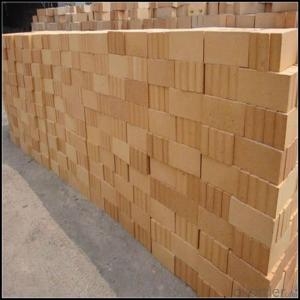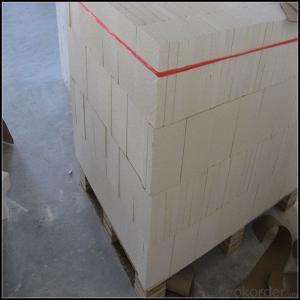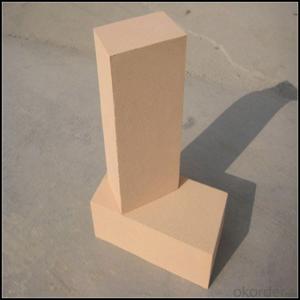High Alumina Refractory Bricks for High Temprature Working
- Loading Port:
- China main port
- Payment Terms:
- TT OR LC
- Min Order Qty:
- 1 m.t
- Supply Capability:
- 500 m.t/month
OKorder Service Pledge
OKorder Financial Service
You Might Also Like
Refractory Brick
CMAX firebricks are classified under temperature between 1300℃ to 1700℃, manufactured from high purity alumina clay by mixing, press-forming, drying, sintering and machining. Bricks contain carefully-graded organic fillers which are burned out during sintering to give a uniform controllable pore structure. This technique makes product feature low thermal conductivity and excellent heat insulation
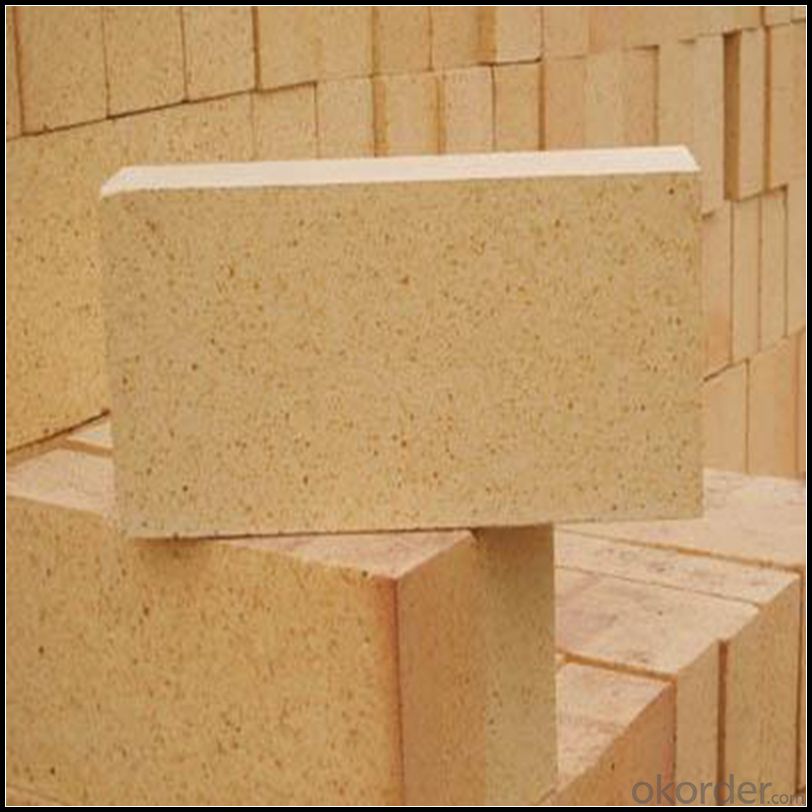
Advantages of high alumina brick
1 Excellent thermal stability
2 High refractoriness under load
3 Chemical stability and anti-corrision
4 Small high temperature creep rate
5 Excellent thermal shock resistance
Characteristices of high alumina brick
1.High intensity for pressure
2. Good thermal shock stability
3. Strong abrasion and corrosion resistance
4. High cold crushing strength
5. Excellent abrasion resistance at cold and hot conditions
Application
1. Furnaces of metallurgy industry, heat treatment furnace
2. Furnaces of chemical industry and construction industry.
3. Furnace of incineration of garbage, recirculating fluidized bed furnace
Data Sheet
Classification Temperature (℉/℃) | 3000/1650 |
Bulk Density (g/cm3 ) | ≤1.0 |
Thermal Conductivity | |
800℃, W/m.K | ≤0.39 |
1000℃, W/m.K | ≤0.43 |
1200℃, W/m.K | ≤0.48 |
Reheating Linear Change (%) | 1550℃×12h |
≤0.9 | |
Chemical Composition (%) | |
Al2O3 | ≥75 |
Fe2O3 | ≤0.5 |
Packaging & Shipping
Packaging Details:Be packed in fumigated wooden pallets
Delivery Detail: 30 days after order

Our Services
Optimum solution and product supply of refractories for high temperature industries, such as iron steel, non-ferrous, petrochemical and building materials.
Engineering design, contract and consult for refractories, and civil architecture design.
Research, development, manufacture and sale of superhard materials.
R&D, manufacture and sale of special packing materials for export.
Inspection, supervision and arbitration of refractories.
Consultation and services in refractories information.
Training and cultivation of high-level talents in refractories profession
Sales Network

Company Information
CNBM (China National Building Material) Group is the largest comprehensive building materials group in China that in integrate scientific research, manufacturing and logistics into one entity. The largest building materials and equipment specialists in China. Upon State Council approval, today CNBM owned more than 300 subordinate manufacturing factories and servicing companies. There are 6 fully owned public listed companies and 11 partially owned with substantial shares public listed companies. In many of these fields, CNBM is playing the leading role in the building industry in the country.
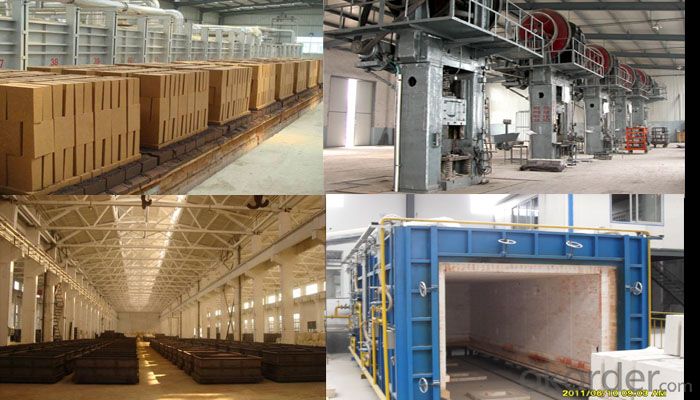
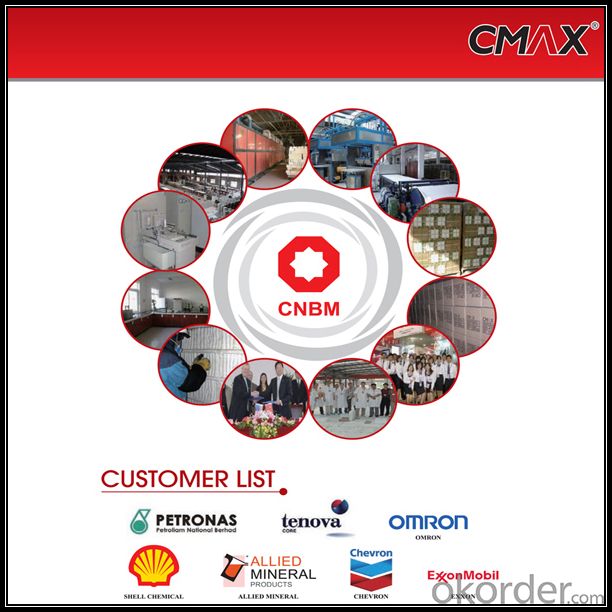
FAQ
1. Which products do you have?
We have all kinds of refractory brick, castable, mortar, cement, ceramic fiber products, etc.
Or you could browse our products to choose what you need.
2. Can you give me a brief introduction of the application of your products?
We are mainly specializing in the refractory materials in iron and steel, cement, glass, ceramics, petrochemical, electric power Industry, etc.
3. If I need your offer, what information do you need?
In order to choose suitable products, it will be appreciated to provide us the information, such us specification, technical data, order quantity, products application etc. If any question, please contact us freely.
- Q:Can insulating fire bricks be used for kiln furniture?
- Yes, insulating fire bricks can be used for kiln furniture. Insulating fire bricks are designed to withstand high temperatures and are commonly used in industrial kilns and furnaces. They have excellent thermal insulation properties, which makes them ideal for creating kiln furniture such as shelves, posts, and supports. The insulating properties of these bricks help to distribute heat evenly throughout the kiln, ensuring that the items being fired are heated consistently. Additionally, insulating fire bricks are lightweight and easy to handle, making them a convenient choice for kiln furniture.
- Q:Is it possible to recycle broken insulating fire bricks?
- It is indeed feasible to recycle damaged insulating fire bricks. These bricks are typically composed of recyclable materials like clay and alumina. After breaking, they can be crushed into tiny particles or ground into a fine powder. These fragments can then be blended with other substances to produce fresh bricks or alternative construction materials. Furthermore, certain recycling facilities may accept broken insulating fire bricks and repurpose them for use in various industries. By recycling these bricks, waste is minimized, resources are conserved, and the environmental consequences of manufacturing new bricks from scratch are reduced.
- Q:Are insulating fire bricks suitable for use in glass melting furnaces?
- Insulating fire bricks can be suitable for use in glass melting furnaces, depending on the specific requirements of the furnace and the type of glass being melted. Insulating fire bricks are made from lightweight materials with low thermal conductivity, which makes them effective at retaining heat and reducing energy loss in the furnace. This can help improve the energy efficiency of the furnace and reduce operating costs. However, it is important to consider the temperature and atmosphere inside the glass melting furnace when choosing the type of insulating fire bricks. Glass melting furnaces operate at extremely high temperatures, often exceeding 1500°C (2732°F). Some insulating fire bricks may not be able to withstand such high temperatures and could degrade or even melt under these conditions. Additionally, the atmosphere inside the glass melting furnace can have an impact on the suitability of the insulating fire bricks. Some types of insulating fire bricks may react with certain gases or chemicals present in the furnace atmosphere, leading to degradation or contamination of the glass being melted. Therefore, it is crucial to select insulating fire bricks that are compatible with the specific atmosphere and conditions inside the glass melting furnace. In summary, insulating fire bricks can be suitable for use in glass melting furnaces, but careful consideration must be given to their temperature resistance and compatibility with the furnace atmosphere. Consulting with experts or suppliers who specialize in refractory materials for glass melting furnaces can help ensure the appropriate selection of insulating fire bricks for optimal furnace performance and glass quality.
- Q:Can insulating fire bricks be used in chimney construction?
- Yes, insulating fire bricks can be used in chimney construction. These bricks have high heat resistance and low thermal conductivity, making them suitable for lining chimneys and other high-temperature applications. They help to insulate the chimney and prevent excessive heat transfer, reducing the risk of structural damage and improving energy efficiency.
- Q:Can insulating fire bricks be used for pizza ovens?
- Yes, insulating fire bricks can be used for pizza ovens. Insulating fire bricks are designed to withstand high temperatures, making them a suitable choice for creating a well-insulated and efficient pizza oven. They help retain heat, allowing the oven to reach and maintain the desired temperature for baking delicious pizzas.
- Q:Are insulating fire bricks resistant to insects and rodents?
- Yes, insulating fire bricks are generally resistant to insects and rodents due to their dense and solid construction, which makes it difficult for pests to penetrate or damage them.
- Q:Can insulating fire bricks be used in the construction of boilers for power plants?
- Insulating fire bricks have the capability to be utilized in the construction of boilers for power plants. These bricks are specially designed to possess a low thermal conductivity, enabling them to retain heat and prevent the loss of energy. This particular characteristic makes them well-suited for high-temperature applications like power plant boilers, where efficient heat transfer is vital for the production of steam and the generation of electricity. Furthermore, insulating fire bricks are lightweight and exhibit good resistance to thermal shocks, making them appropriate for the demanding conditions typically encountered in power plants. On the whole, incorporating insulating fire bricks into the construction of boilers can enhance energy efficiency and diminish heat loss, resulting in improved operational performance and cost savings for power plants.
- Q:What is the specific heat capacity of insulating fire bricks?
- The specific heat capacity of insulating fire bricks may differ depending on their specific composition and manufacturing process. Nevertheless, compared to other brick types, insulating fire bricks generally exhibit a relatively high specific heat capacity. This characteristic enables them to effectively absorb and retain a significant amount of heat energy without experiencing a substantial rise in temperature. Typically, the specific heat capacity of insulating fire bricks falls within the range of 0.8 to 1.2 kilojoules per kilogram per degree Celsius (kJ/kg°C). It should be noted that factors such as brick density, porosity, and temperature range of use can also influence the specific heat capacity.
- Q:Do insulating fire bricks require a specific curing or drying process before use?
- Yes, insulating fire bricks typically require a specific curing or drying process before use. This involves gradually heating the bricks to remove any moisture or volatile materials present, which helps to prevent cracking or damage during subsequent use. The exact curing or drying process may vary depending on the specific type and manufacturer of the insulating fire bricks.
- Q:Are insulating fire bricks suitable for use in the construction of incinerators?
- Yes, insulating fire bricks are suitable for use in the construction of incinerators. Insulating fire bricks are specifically designed to withstand high temperatures and provide excellent insulation properties. Incinerators operate at extremely high temperatures, often exceeding 1000 degrees Celsius, and require materials that can withstand these intense conditions without cracking or deteriorating. Insulating fire bricks are made from lightweight refractory materials, such as ceramic fibers or lightweight aggregates, which have low thermal conductivity. This means that they are able to effectively insulate the incinerator, preventing heat from escaping and ensuring maximum energy efficiency. The insulation properties of these bricks also help to maintain a consistent temperature inside the incinerator, which is crucial for proper combustion and waste disposal. Furthermore, insulating fire bricks have excellent resistance to thermal shock, allowing them to withstand repeated heating and cooling cycles without damage. This is crucial in incinerators, where the temperature can fluctuate rapidly during the burning process. The bricks' ability to withstand thermal shock ensures their durability and longevity in this high-temperature environment. In addition to their insulation and thermal shock resistance, insulating fire bricks also offer other benefits for incinerator construction. They are lightweight, making them easier to handle and transport during the construction process. They can also be easily cut or shaped to fit specific designs or requirements, allowing for flexibility in the construction of incinerators. Overall, insulating fire bricks are an ideal choice for the construction of incinerators due to their high-temperature resistance, insulation properties, thermal shock resistance, durability, and ease of use. They provide a reliable and efficient solution for containing and maintaining the intense heat generated in incinerators, ensuring safe and effective waste disposal.
1. Manufacturer Overview |
|
|---|---|
| Location | |
| Year Established | |
| Annual Output Value | |
| Main Markets | |
| Company Certifications | |
2. Manufacturer Certificates |
|
|---|---|
| a) Certification Name | |
| Range | |
| Reference | |
| Validity Period | |
3. Manufacturer Capability |
|
|---|---|
| a)Trade Capacity | |
| Nearest Port | |
| Export Percentage | |
| No.of Employees in Trade Department | |
| Language Spoken: | |
| b)Factory Information | |
| Factory Size: | |
| No. of Production Lines | |
| Contract Manufacturing | |
| Product Price Range | |
Send your message to us
High Alumina Refractory Bricks for High Temprature Working
- Loading Port:
- China main port
- Payment Terms:
- TT OR LC
- Min Order Qty:
- 1 m.t
- Supply Capability:
- 500 m.t/month
OKorder Service Pledge
OKorder Financial Service
Similar products
New products
Hot products
Related keywords
